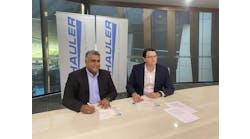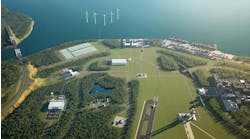It says something about Yokogawa’s reputation as a source of good quality copy that, for the second time in a year, it’s been able to persuade U.K. hacks to get up soon after 3.00 a.m. to catch a 7.00 a.m. flight. Last February, it was for the launch of the new CentumVP DCS in Amsterdam; this time it was to pay a fleeting visit to the company’s fourth biennial European user conference in Barcelona in the last week of September. However, perhaps by way of a reward for dedication above and beyond the call of duty, this time, rather than packing them back on the EasyJet to Gatwick straight after the press conference, the press were put up for the night in the extraordinarily swanky Hotel Rey Juan Carlos I which hosted the conference. That didn’t just enable them to attend a small selection of the conference presentations the following morning, but to join a guided coach tour of the city and enjoy a “Gala Dinner” – in truth a stand-up buffet which put no small strain on those who hadn’t seen their beds since 3.30 a.m. – in the even more impressive surroundings of the 15th century Casa Llotja de Mar, headquarters of Barcelona’s Chamber of Commerce. As we’ve noted before, it’s a tough job but someone’s got to do it!
Radio silence
What did the Yokogawa team have to say on this occasion to justify adding another third of a tonne of CO2 per head to the atmosphere? At first sight, not a great deal but, as is also becoming the norm at Yokogawa events, there was probably as much significance in what was not said as in what was. So there was little or nothing to add to what had been said about CentumVP back in March, with still no sign of the plant- wide, real-time database which is, arguably, its most innovative feature and remains scheduled for release in 2009. Similarly on wireless, almost certainly the subject at the top of most attendees’ agendas, field networks marketing manager Henk van der Bent had just one rather grudging sentence to add to the presentation he had made to the conference earlier in the day. That wouldn’t have mattered too much were it not for the fact that most of those attending the press conference had been 30,000 feet above the Pyrenees at that point in the conference programme.
Coming soon
First up, however, before van der Bent, of whom more later, was European asset technical services development manager Michael Büsselmann, whose presentation highlighted Yokogawa’s increasing stress on the interaction between corporate level strategic decision making and production and plant level operations. Promised for next year are further additions to the CentumVP portfolio, including a Plant Information Manager with the capability to create KPIs (key performance indicators) which can be monitored within a KPI dashboard; a new Consolidated Alarm Management (CAM) suite providing facilities for enhanced alarm management, including alarm suppression; and an OPC-based Plant Information Exchange tool providing the ability to integrate third- party applications and bring their data into the CentumVP HMI; all made possible by the new real-time database and IReal Time Production Organizer.
Meanwhile, however, confirming ARC’s view that the most rapid growth in DCS revenues is coming from services, Yokogawa is introducing a range of “Services to Operational Excellence,” based on the Six Sigma cycle – define, measure, analyse, improve, control – and aimed at covering the full cycle of operational improvement from identifying an opportunity through implementing a solution to maintaining the effectiveness of that solution throughout the plant’s life cycle. Opportunity Identification Services are designed to help users recognize both capital and operational expenditure opportunities which, typically, according to the Frauenhofer Institute, can yield performance improvements of between 20% and 30% through increased production efficiency, plant availability and safety.
Once those opportunities have been identified and their potential benefits quantified, Yokogawa’s Solution Implementation Services provide both engineering and consultative support for such functions as alarm rationalisation and control room design. Finally, in the longer term, life-cycle effectiveness services ensure that initiatives continue to deliver improvement through service and support, maintenance and inventory management, migration support and ongoing effectiveness analysis.
Instrumentation over IP
All of which, while interesting, probably didn’t make up for that 3.00 a.m. alarm call. What did was the keynote presentation delivered the following morning by senior vice president of R&D Toshiaki Shirai that lifted a corner of the veil hiding Yokogawa’s thinking beyond 2010. In so doing, it reemphasised the message delivered by Industrial Automation Systems Business division vice president Masotoshi Nakahara at the launch of CentumVP that the aim was “to introduce IT technology to automation systems.” To judge from Shirai San’s presentation, it isn’t just to introduce IT technology, but to drive it right down to the lowest level of the automation hierarchy. Hence his emphasis on what he calls “Field Ubiquitous Computing” and, more specifically, to “Instrumentation over IP.” Field Ubiquitous Computing, he explained, provides the means to deliver information “From anywhere, at anytime, autonomously, vividly as if on-site and from the user’s viewpoint,” and hence to provide the basis for “fast adaptation to change.” This approach, he claimed, will enable sensors and control devices continuously to diagnose their own condition and autonomously to execute their own predictive maintenance. At the same time, devices on the plant will be able to conduct autonomous dialogue with human operators who will in turn be able to operate remote distributed facilities from a single operations centre.
Flatter architecture
Key to the realisation of this vision is a new, flatter system architecture with enterprise, HMI, controller and field devices communicating over a common IP network. Yokogawa already has the basic building blocks in place for a secure, intrinsically safe IPv6-based field network and for the development of a robust Field Overlay Architecture incorporating both conventional and wireless communications. One development that Shirai San sees emerging in parallel with Field Ubiquitous Computing is the concept of a tracking simulator using real-time models to predict the behavior of actual plant and feed-forward its findings to enable early fault detection, minimize accidents and associated down time and process optimisation.
Also announced at the Barcelona user conference was Yokogawa’s move to join the growing trend for DCS vendors to enter into partnerships to provide a one-stop shop for machinery health monitoring for large rotating equipment including, in particular, large gas compressors. In Yokogawa Europe’s case, the relationship is with Danish condition- monitoring specialist Rovsing Dynamics and targets the upstream and downstream oil and gas industries including offshore oil and gas production, FPSOs, downstream LNG facilities, refineries and onshore gas compression stations. Rovsing’s OPENpredictor, a machinery health tool, will be integrated into VigilantPlant solutions based on Yokogawa’s CentumVP DCS and PRM (Plant Resource Manager) asset management system. The Rovsing system provides automated fault diagnostics and predicts lead time to inspection for mission critical rotating machinery.



